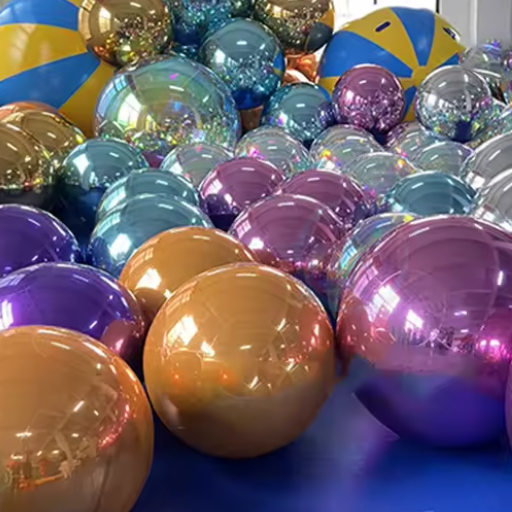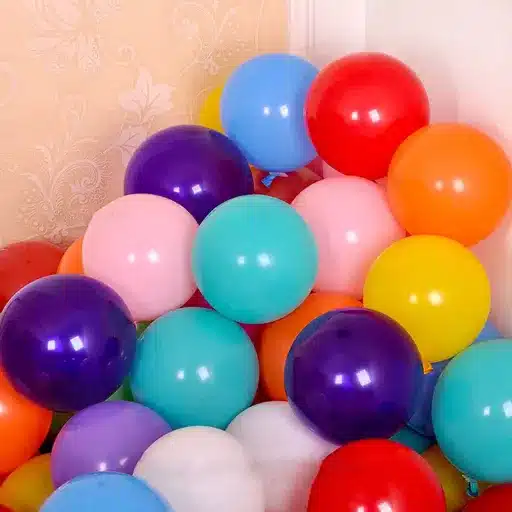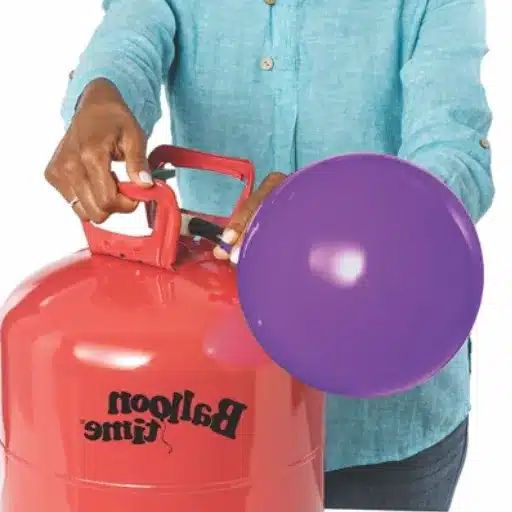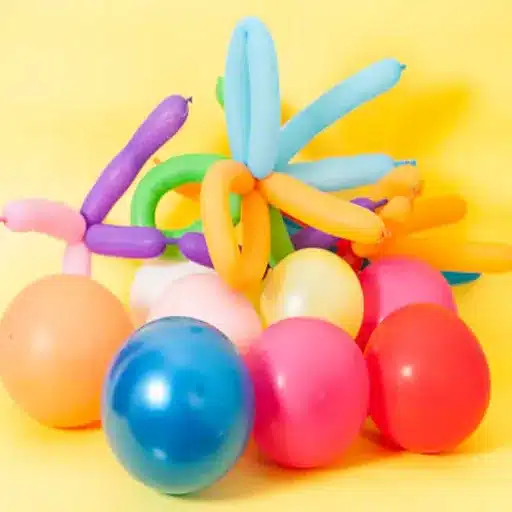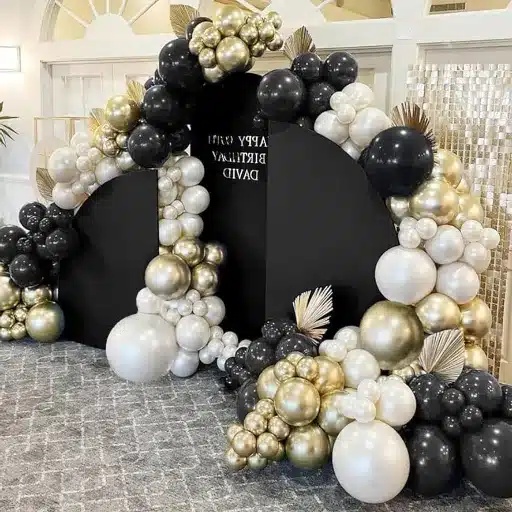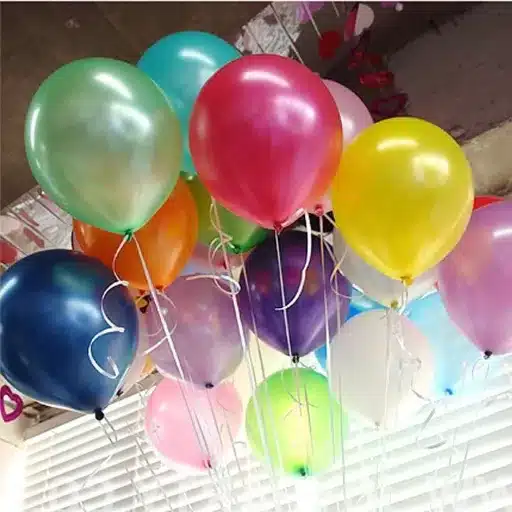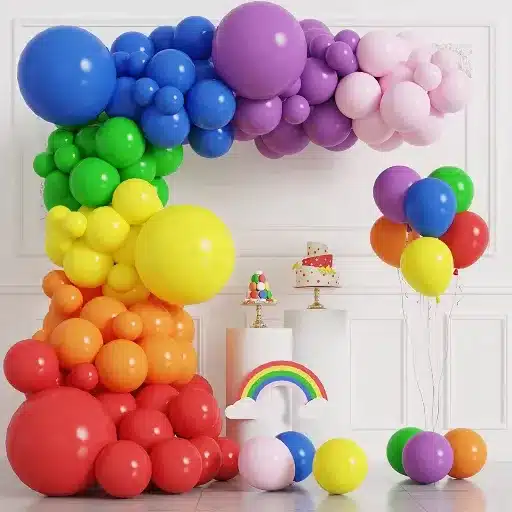Planning the perfect event involves managing innumerable details, with balloons being a popular choice for creating a cheerful and eye-catching atmosphere. However, one question sometimes makes or breaks your décor plans: How long could a balloon stay inflated? Whether helium is making your balloons float for dramatic displays or your renderings involve air-filled balloons for intricate designs, understanding their longevity is essential to ensure your decorations remain beautiful throughout your event. We’ll talk about some factors affecting how long a balloon stays inflated and include some valuable tips for maximizing balloon life, so you can make the best decisions to keep things picture-perfect through to the end of the celebration.
Understanding Balloon Lifespan

Factors Affecting How Long Balloons Last
A combination of material type, environmental conditions, and usage influences the lifespan of a balloon. A latex balloon, being biodegradable and somewhat porous, tends to get deflated faster than a foil balloon. On the other hand, foil ones, being non-porous in nature, can hold helium or even air for several days to even weeks in the right conditions.
Temperature describes the significant phenomena where gas can expand inside, leading to overinflation and popping, while cold weather helps with contraction and deflation. Humidity plays a crucial role in the cracking of latex balloons over time. With the sun’s harsh rays hitting the balloons, the deterioration of the balloon material starts soon, making them unsuitable for speedy deflation or long life. Proper inflation and sealing prevent ballooning; any poorly tied or not-at-the-incumbent-sealing can certainly lead to faster leaks. Knowing these would guarantee that your balloon exhibits dancing colors and stays inflated for as long as possible.
Differences between helium and latex balloons
Helium and latex balloons greatly differ from one another in composition, application, and utility. Helium balloons are usually made of Mylar or metallic foil and are designed to be helium-resistant, allowing them to retain lift for a prolonged period. These kinds of balloons are used mainly for occasions where long displays are needed, and the helium will enable them to float smoothly in the air because they are lighter than air. Latex balloons are made from biodegradable natural rubber and serve as cheaper alternatives that find use in many more ways. Latex balloons hold down the air or helium but lose it faster than others due to their porous nature, resulting in a much shorter time to float.
The other significant difference, then, is their durability and environmental friendliness. Helium balloons, especially foil ones, are not biodegradable and thus must be disposed of consciously so as not to become a source of pollution. Latex balloons, however, are biodegradable and have a much shorter lifetime, but they can still bring about pollution if discarded improperly. To add to that, helium balloons are exceedingly sensitive to temperature changes because, as heat rises, helium expands and escapes. In contrast, with latex balloons, it is in a way more flexible, with physical damage being the only threat, such as popping or deflating with time.
Finally, in terms of looks and customization, helium balloons come in intricate designs and shapes for themed parties. In contrast, latex balloons offer more colors for decorating arches, bouquets, or table centerpieces. By fully understanding their differences, people who want to buy balloons can physically weigh their cost, looks, and sustainability to make the most appropriate purchase.
How Long Do Helium Balloons Last?
The life span of helium balloons varies depending on several factors, including the quality of material used, environmental conditions, and, of course, size. Latex helium balloons usually last for 8-12 hours before they begin to deflate since helium molecules gradually diffuse out through the porous surface of the latex. If sealed with a sealant like Hi-Float, their lifespan can be increased to 2-3 days as it works to slow down the actual loss of helium. Conversely, foil or Mylar balloons tend to be less permeable and may keep helium for a few days, sometimes even over a week. Temperature changes or direct sunlight, among other environmental factors, affect the longevity of whatever balloon is in question. Cooler times generally promote more extended float periods, whereas heat awakens helium expansion and premature deflation. Choosing suitable balloon materials and conditions, therefore, could allow your event or celebration to be displayed for an extended period.
Maximizing Balloon Inflation Duration
Extend their Lifespan Tips
Choosing High-Quality Materials:
Opt for custom latex or foil balloons that offer greater durability and are less prone to early deflation. Use treatments on latex balloons like the Hi-float solution; it gels on the interior and somehow helps seal the tiny pores in the balloon, greatly increasing the time the balloon floats in helium.
Inflating Balloons Properly:
Overinflated balloons tend to burst, particularly in high temperatures; underinflation shortens balloon life. Control the pressure from the helium tank and use it properly for consistent balloon inflation. Also, ensure that balloons are filled to the recommended size.
Keep Balloons in Cool Areas:
Cooling helps increase balloon life. Keep balloons away from the sun and hot spots; heat causes the helium inside to expand and leak out. Cooler interiors work well in keeping them inflated for longer.
Using Balloon Sealants:
Balloon sealants can really save the day when it comes to latex balloons. These sealants form an invisible barrier inside the balloon, preventing the helium from leaking through the surface and deflating too quickly.
Proper Storage and Transport:
Before your event, keep the balloons sealed in a dark and cool place away from any sharp objects or rough surfaces that might damage them. While transporting them, keep them secured inside a vehicle with enough space so that they are not mistreated or popped in transit.
Double-Stuff Balloons:
Putting one balloon inside another not only adds to the durability but also offers much room for creative layering and maintains the helium for longer. This technique works best with latex balloons.
Following these easy-to-implement tips will ensure your balloons stay festive for as long as possible, providing a really vibrant display for any event.
Environmental Factors Affecting Balloon Longevity
Having stayed in the sun, the balloon would quickly be destroyed. The sun’s powerful UV rays destroy its material. That results in fading, color loss, or even bursting. While high or low temperatures could affect latex or foil balloons, heat is crucial: It causes popping by making the helium expand, while cold makes the helium contract, leading to deflation.
Humidity is another critical factor. Latex balloon rubber is less elastic when exposed to moisture, making it more prone to rupture. Wind imposes mechanical stress on balloons, leading to potential physical damage or tangling. Exposure to these elements, like dirt and pollutants, may hinder balloon life even more. By considering all of these environmental factors for the balloons, suitable decisions can be made regarding their placement and conditions to maximize the time they will look worthy of a celebration.
Best Practices for Inflating Balloons
After specific inflation techniques are properly performed, the balloons will enjoy a longer life and a more beautiful appearance. Begin by choosing a sturdy and high-quality air pump or inflating device to ensure an exact flow of air or helium is maintained without over-inflation, which can create excessive strain on the balloon wall and eventually cause it to burst. Take care to consider the type of balloon. For example, latex balloons strictly require an exact inflation, as their elasticity strongly depends on the inflation level. In contrast, foil balloons tend to be more forgiving and less prone to bursting if handled with care.
Consider temperature and humidity as well: excess heat causes the balloon to enlarge further, thus risking a rupture; on the other hand, cold environments may increase the chance of the balloon falling off or turning brittle. Similarly, during the inflation procedure, keep the working party out of contact with any scratchy, abrasive surface that may induce pinholes or tears in the balloons.
For helium balloons, high-grade helium helps prolong the period of floating. Latex balloons can also be treated with one or more coats of Hi-Float or a comparable product to extend their float time significantly. Treasure these proven practices to help balloons achieve their desired look and last longer on any occasion.
Types of Balloons and Their Durability
Latex Balloons: How Long Do They Last?
The lifespan of latex balloons depends on several variables: the quality of materials, the environment, and whether they were filled with air or helium. Usually, in an indoor environment, an air-filled latex balloon lasts for several days to weeks because relatively short temperature changes do not affect it much. When filled with helium, the latex balloon tends to float for about 8-12 hours under normal conditions. This period may be further improved to twenty-four hours or even more using Hi-Float. Environmental factors like heat, sunlight, and wind will expedite the degradation of latex balloons; therefore, proper storage and display will ensure their longevity. Equipped with the knowledge of these variables, one can time events quite well to maintain the appearance of the balloons. Find more info now.
Mylar Balloons or Latex Balloons?
Comparing Mylar and latex balloons, both possess different traits that make them suitable for specific occasions and applications. Being made of metallic materials, Mylar balloons were more hardy and could retain helium for much longer, sometimes remaining airborne for a few days to several weeks. They are often equipped with loud designs and crisp and highly reflective surfaces, ideal for themed parties, complicated decorations, or custom printing. On the other hand, latex balloons are made from natural rubber; hence, they are biodegradable and eco-friendly. They are ambidextrous, inexpensive, and come in a multitude of shapes and sizes.
The two types of balloons warrant consideration of some factors. Latex balloons tend to pop if exposed to extreme heat or direct sunlight, and disposing of Mylar balloons neatly is difficult because they are not biodegradable. Your decision will depend on the particular need of the event, one’s view on environmental impact, and one’s budget. Once these factors have been weighed, the best possible choice of balloon will be ideally suited to your event.
Custom Balloons: Lifespan Considerations
The lifespan of custom balloons is highly susceptible to the materials, designs, and handling procedures adopted. Latex balloons usually last anywhere from 12 to 24 hours when filled with helium. Still, other factors may come into play —such as temperature, humidity, and altitude, which could actually influence their longevity. Proper handling, such as sealing the balloons after filling with helium or treating them with an extender solution, would ensure greater durability. Conversely, Mylar balloons travel farther, keeping the lifts going for days, even weeks, making them an excellent solution for longer events or decorating. Once you know the basics of maximized lifespan, your custom balloons have to be stored in a cool, dry place before inflation, and definitely not be overfilled. This kind of information enables event planners or content creators to align balloon choices with their functional and aesthetic needs, resulting in a win-win outcome.
Balloon Decorations and Their Longevity
How Long Do Balloon Decorations Last?
The lifespan of balloon decorations depends on many factors: the type of balloons used, environmental conditions, and handling. Latex balloons usually last 12 to 24 hours if filled with helium, though this could be extended to 2 or 3 days if coated with hi-float. Foil or Mylar balloons could stay for days or even weeks if kept indoors. Being outdoor decorations, weather conditions like heat and strong winds could somewhat reduce their lifespan. These factors must be accounted for by the event planner so that decorations will look fresh and fabulous throughout their intended duration. Getting the right material balanced with the best preparation methods guarantees longevity and also pleases the eyes.
Tips for Balloon Decor That Lasts
Here are some pointers to help your balloon decor stand the test of time: materials, environment, and ideal placement. Choose good-quality latex or foil balloons that can withstand minor wear and tear. For outdoor use, consider using UV-resistant balloons to prevent sunlight from fading them, and ensure proper inflation methods that avoid over-expansion, which can cause bursting. You may also want to apply a protective coating, like Hi-Float, to the latex balloons to significantly increase their life.
Temperature and humidity are also crucial; heat causes balloons to expand and pop, and a sharp temperature decline can make them deflate. In controlled environments such as indoors, keep the room temperature steady so that your balloon decor remains bright. At the same time, you should stabilize your balloon arrangements with weights, especially outdoors, to counter the strong winds.
Designs should protect against harsh weather, preferably through shade or tents. In conjunction with these measures, such arrangements promote the beauty of décor throughout the event and also the satisfaction of guests. While making use of these tips, in a nutshell, it is possible to constantly ensure making everlasting and beautiful balloon displays that leave an impression.
Creative Ways to Use Balloons for Events
From being simple party adornments, balloons nowadays are employed as highly versatile and impactful design tools for all types of events. Here are a few ideas to get those balloons out into the event, where they will attract the attention of guests and work on enhancing the ambiance.
Balloon Backdrops and Transformations:
Transforming any space through the creation of an elaborate balloon backdrop is a fascinating activity. Photo-worthy installations created by combining colors, shapes, and textures can double as branding opportunities for corporate events or as the thematic focal point for personal celebrations. To add to the glamour, metallic accents or LED indirect lighting can be added to the display.
Floating Centerpieces:
Safe from the tried and tested table centering options, balloons explore afar. Clear balloons filled with helium, with here and there confetti or floral inserts, promote whimsical, if elegant, vibes. Floating centerpieces keep good table space and establish an airy feeling.
Themed Entrances and Arches:
Greet your guests with personalized balloon arches or tunnels that set the event’s tone. Coordinate the balloon design to the theme: think gradients, gigantic balloons, or floral accents for an entrance worth remembering.
Balloon Walls for Branding or Guest Engagement:
Balloon walls do not merely serve mesmerizing visual appeal; they also offer some level of pragmatism. Use them as a creative space for event branding, message displays, or even activities that encourage guest interaction, such as photo-taking spots or “pop for a prize” walls for interactive games.
Suspended Balloon Installations:
For an immersive ambience, balloons hang from ceilings in clusters, lines, or abstract shapes. With suspended arrangements, a dreamy effect is guaranteed, befitting gala dinners, receptions, or even retail launches, imbuing both scale and elegance into their design.
Green Alternatives for Balloons:
With a high demand for sustainable events, you could opt for biodegradable latex balloons or consider reusable ones like mylar. These solutions offer a good balance between ingenuity and environmental consciousness, thus satisfying the concerns of modern-day event organizers without compromising on style.
Incorporating all these innovative methods into a design will allow event managers to work with balloons as though they were unique design elements of their own and create an unforgettable impression for guests, in line with modern trends.
Common Myths About Balloon Lifespan
Misconceptions About Helium Balloons
One of the common misconceptions about a helium balloon is that it floats forever, which is not true. My research shows that, depending on a variety of factors, such as the type of material it is made of and the surrounding environmental conditions, a helium balloon has an actual lifespan. For example, helium latex balloons will generally float for about 12 to 24 hours in normal weather before they lose buoyancy. The reason is that helium molecules are tiny and can pass through tiny pores in latex material, given some time. On the contrary, mylar (or foil) balloons are less porous and will hold onto the helium longer, sometimes floating for days or maybe even weeks under favorable conditions.
Another common myth is that helium balloons will behave the same everywhere, but temperature does matter. Extreme heat can make helium gas expand so that the balloon may burst; below-freezing temperatures make it contract, decreasing the buoyancy of the balloon. From my observation, holding the balloons in moderate and settled conditions not only extends their life but also retains their visual charm in the course of events.
The last assumption I hit was that adding more helium can keep the balloon afloat forever. At the outset, adding helium may increase buoyancy. But it is a natural property of helium, and being restricted by the material of the balloon, the balloon would always have a decreased float time. But, in the case of using hi-floats or some treatments for the interior of latex balloons, the floating time will get extended so that they can be suitable for long events or celebrations. Knowing these things would go far to help dispel several myths, and you really want to plan accordingly when using helium balloons in decorations.
The Truth About Latex Balloons
From my own experience and research, latex balloons have their strengths and limitations, with these issues making for a popular yet often misunderstood decorative choice. Natural rubber is the raw material used for latex balloons, biodegradable and environmentally friendlier than alternatives such as plastics. In decomposition, the latex balloons mostly break into small fragments with time, thus minimizing their environmental impact. Otherwise, the degradation of latex balloons can take anywhere from a few months to years, depending largely on exposure to sunlight and oxygen; hence, they should be disposed of carefully. The use of good-quality latex and responsible disposal can reduce environmental concerns.
Probably the most important ongoing problem with latex balloons is their finite helium fill-based float time. Helium molecules are so tiny that they can simply escape through microscopic pores in the rubber, practically rendering the balloon airtight only in appearance. As a rule of thumb, the float time in untreated latex balloons ranges anywhere between 12 and 24 hours. This, combined with Hi-Float coating inside the balloon, doubles float times so that the balloons may be used longer for an event. Heavily filled balloons may speed helium evaporation or balloon bursting, so correct filling to the right size is key to doing well and lasts a lot longer.
On a practical level, I tell ya: Designing garlands and decor that didn’t need to float was one way to save helium and money by using air-filled latex balloons. Air-filled balloons, in turn, retained their aesthetic appeal longer, sometimes for weeks, especially when they were paired creatively with accessories, such as balloon arches or stands. By understanding these subtleties, one can plan better and enhance the possibilities of latex balloons, be they for large, grand celebrations or smaller, intimate affairs.
What Really Affects Balloon Inflation Time?
According to my research, many factors affect the time needed to inflate a balloon efficiently. First and foremost, the material used for the balloons has an enormous effect on achieving quick inflation. Latex balloons stretch and expand, requiring much work to inflate, unlike foil balloons that expand with almost no resistance and have minimal flexibility. The size of the balloons matters since filling bigger balloons will take more time due to the larger volume of the balloons. From the power and the device used for inflation, the efficiencies vary, therefore allowing less time in the case of electric pumps as compared to a hand-held or manual pump.
Could it be the procedural method of inflation? All things being equal, inflating at the correct time will fill the balloons evenly and fast without fear of bursting. But first off, such factors as temperature might be placing themselves between the goodness of your balloon and the tempest of its distress. Hence, a high temperature will practically let latex balloons get stretched, while on a colder day, it may feel harder to say, wax. Another from the list of good helpers would be the automatic balloon inflators, since they ease the job tremendously when huge quantities of balloons have to be inflated for an event. Now, conversant with times and strategies of inflation and their effect on balloon quality, I can carry out any balloon work in an efficient way.
Reference Sources
How Long Do Balloons Stay Inflated
Provides details on the typical float times for helium-filled latex balloons and tips to extend their lifespan.
How Long Do Balloons Last? – Cairns
Explains the lifespan of different types of balloons, including latex, foil, and plastic bubble balloons.
How Long Do Helium Balloons Last?
Discusses the float time of helium balloons and offers insider tips for multi-day events.
How to Make Latex Balloons Last Longer
Shares practical advice on extending the life of latex balloons through proper inflation, storage, and the use of Hi-Float.
Tips for Maximum Float Life
Offers advanced tips for maximizing balloon float time, including the use of Hi-Float and climate-controlled storage.
Frequently Asked Questions (FAQs)
For a balloon filled with helium, how long will it stay inflated?
Helium balloons typically stay afloat for 12 to 24 hours, with the given time period varying according to different factors. Among them is the size of the balloon, taking the primary role in flotation, given that bigger helium balloons tend to float longer than the smaller ones. Another factor that will influence how long helium will remain inside the balloon is the condition of the environment or the room: temperature, relative humidity, etc. It is rewarding to keep them inside away from sunlight and heat rays so that their float time can increase: sunlight and heat increase the rate of helium expansion and hence increase their escape. For best results, just consider inflating with pure helium, which keeps the balloon afloat for longer.
How long do latex balloons typically last when filled with air?
Eyelets of latex balloons filled with air can remain inflated for several days, or even several weeks, depending on the size and the surroundings. Air-filled latex balloons retain their shape much longer than helium-filled ones that float. They should be kept inside in the coolest and driest place possible and must be protected from direct exposure to sunlight to guarantee longer inflation time. One can also apply balloon sealant to stop escaping air. The balloons’ flying time is quite variable and depends on the thickness of the balloon and the environment.
What influences the staying time of the helium balloons?
Several environmental factors determine the length of time helium balloons last. One of the most prominent factors is the temperature: warm temperatures will cause the helium inside the balloon to expand and escape at a faster rate. Sun-exposed balloons tend to deflate sooner, again due to heat exposure. Another factor impacting the life span of balloons is balloon size: larger balloons will usually keep helium longer. Last, but not least, the ability of the balloon’s material to hold helium better could be affected; choosing good-quality balloons is very crucial for keeping them for a longer time.
How could I keep balloons for an extended period?
To ensure balloons stay inflated and last for as long as possible, consider certain factors. Do not expose balloons to sunlight or high or low temperatures, because the helium can dissipate quite rapidly in such situations. Another method to prevent helium from escaping is by coating the inside of the balloon with balloon sealant. Also, keep the balloons in a cool and dry environment. And lastly, favor the bigger ones, because larger ones tend to stay inflated longer.
How long do foil balloons stay inflated compared to latex balloons?
Foil balloons are simply better at maintaining their inflation than latex balloons. While latex helium balloons deflate in anywhere between 12 and 24 hours, foil balloons could remain inflated for several days, or even weeks, depending on factors such as temperature and humidity. Foil balloons have less porosity than latex, hence preventing helium from escaping quickly. On the downside of the long-lasting characteristic is how sharp things could pop them quickly. If doing a display, foil balloons will last a lot longer than latex.
What should I avoid to extend the life of my balloons?
A couple of things that you should not do if you want your balloons to last longer. To start, keep balloons out of sunlight. Direct rays cause the material to degrade, allowing quicker helium escape. Avoid extremes of temperature, sunlight included. Helium can expand and escape faster in hot weather. Overinflate not, either, since this makes balloons more apt to pop. Gentler handling is better, too-those rough pugmarks can tear or puncture. Following these hints can give your balloons a longer road to be let down.

